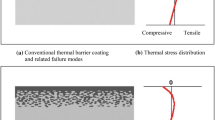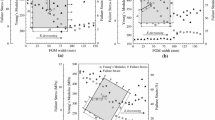Abstract
The problem of brittle crack propagation and fatigue crack growth in functionally graded materials (FGMs) is addressed. The proposed analytical approach can be used to estimate the variation of the stress-intensity factor as a function of the crack length in FGMs. Furthermore, according to the Paris’ law, the fatigue life and the crack-tip velocity of crack propagation can be predicted in the case of fatigue crack growth. A comparison with numerical results obtained according to the Finite Element method will show the effectiveness of the proposed approach. Detailed examples are provided in the case of three-point bending beam problems with either a FGM interlayer, or a FGM external coating. A comparison is presented between two types of grading in the elastic modulus: a continuous linear variation in the FGM layer and a discrete approximation with a multi-layered beam and a constant Young’s modulus in each layer.
Similar content being viewed by others
References
Carpinteri A (1982) Notch sensitivity in fracture testing of aggregative materials. Eng Fract Mech 16:467–481
Carpinteri A (1987) Stress-singularity and generalized fracture toughness at the vertex of re-entrant corners. Eng Fract Mech 26:143–155
Carpinteri A (1997) Structural mechanics: a unified approach. Chapman & Hall, London
Carpinteri A, Paggi M (2005) On the asymptotic stress field in angularly nonhomogeneous materials. Int J Fract 135:267–283
Carpinteri A, Pugno N (2005) Fracture instability and limit strength condition in structures with re-entrant corners. Eng Fract Mech 72:1254–1267
Carpinteri A, Pugno N (2006) Cracks and re-entrant corners in functionally graded materials. Eng Fract Mech 73:1279–1291
Carpinteri A, Paggi M, Pugno N (2006) Numerical evaluation of generalized stress-intensity factors in multi- composites. Int J Solids Struct 43:627–641
Chawla KK (1987) Composite materials: science and engineering. Springer-Verlag, NewYork, Berlin, Heidelberg, London, Paris, Tokyo
Chi S-H, Chung Y-L (2003) Cracking in coating-substrate composites with multi-layered and FGM coatings. Eng Fract Mech 70:1227–1243
Delale F, Erdogan F (1983) The crack problem for a nonhomogeneous plane. ASME J Appl Mech 50:609–614
Eischen JW (1987) Fracture of nonhomogeneous materials. Int J Fract 34:3–22
Erdogan F (1995) Fracture mechanics of functionally gradient materials. Compos Eng 5:753–770
Erdogan F, Wu BH (1997) The surface crack problem for a plate with functionally graded properties. ASME J Appl Mech 64:449–456
Fett T, Munz D (1997) Stress intensity factors and weight functions. Computational Mechanics Publications, Southampton
Fett T, Tilscher, Munz D (1997) Weight functions for cracks near the interface of a bimaterial joint, and application to thermal stresses. Eng Fract Mech 56:87–100
Forth SC, Favrow LH, Keat WD, Newman JA (2003) Three-dimensional mixed-mode fatigue crack growth in a functionally graded titanium alloy. Eng Fract Mech 70:2175–2185
Gu P, Dao M, Asaro RJ (1999) A simplified method for calculating the crack-tip field of functionally graded materials using the domain integral. ASME J Appl Mech 66:101–108
Jin Z-H, Batra RC (1996) Some basic fracture mechanics concepts in functionally graded materials. J Mech Phys Solids 44:1221–1235
Kim J-H, Paulino GH (2002) Mixed-mode fracture of orthotropic functionally graded materials using finite elements and the modified crack closure method. Eng Fract Mech 69:1557–1586
Kim J-H, Paulino GH (2003) T-stress, mixed-mode stress intensity factors, and crack initiation angles in functionally graded materials: a unified approach using the interaction integral method. Comput Methods Appl Mech Eng 192:1463–1494
Murakami Y (ed) (1987) Stress intensity factors handbook. Pergamon, Oxford
Paulino GH (eds (2002) Fracture of functionally graded materials. Eng Fract Mech 69:14–16
Xu FM, Zhu SJ, Zhao J, Qi M, Wang FG, Li SX, Wang ZG (2003) Fatigue crack growth in SiC particulates reinforced Al matrix graded composite. Mater Sci Eng A 360:191–196
Author information
Authors and Affiliations
Corresponding author
Rights and permissions
About this article
Cite this article
Carpinteri, A., Paggi, M. & Pugno, N. An analytical approach for fracture and fatigue in functionally graded materials. Int J Fract 141, 535–547 (2006). https://doi.org/10.1007/s10704-006-9012-y
Received:
Accepted:
Published:
Issue Date:
DOI: https://doi.org/10.1007/s10704-006-9012-y




